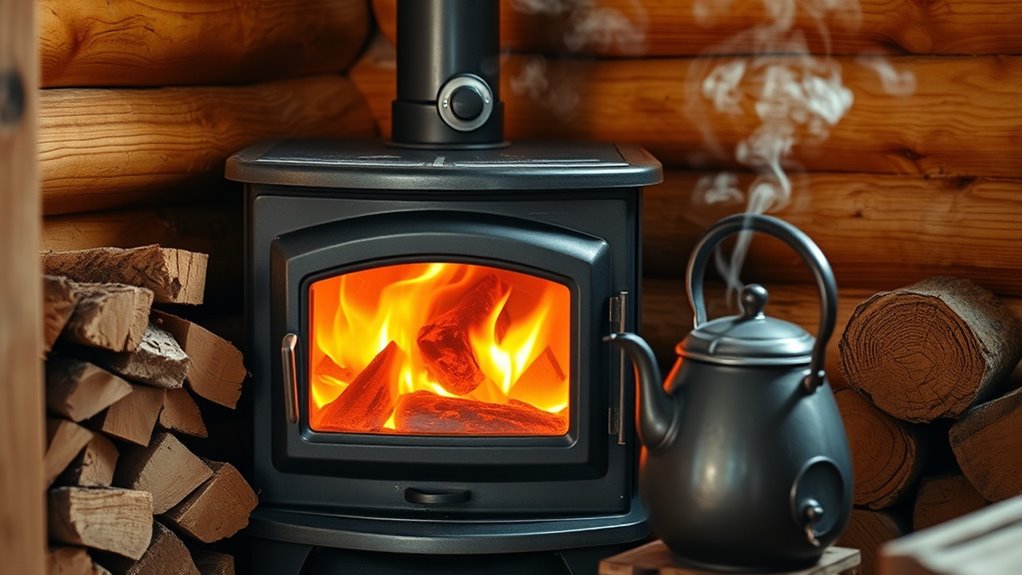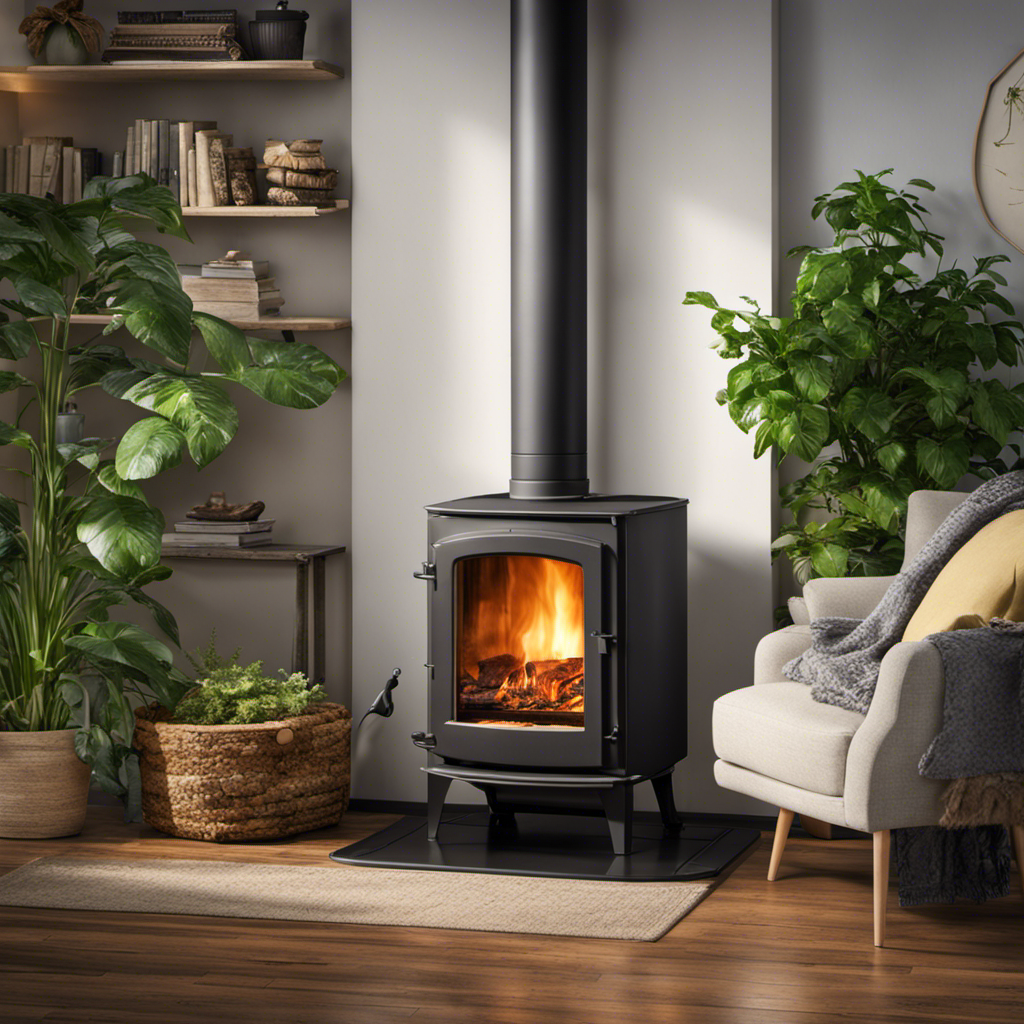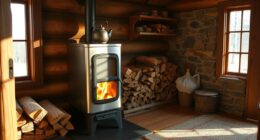To maximize heat from your small wood stove, start by choosing the right type and size of wood—hardwoods like oak burn longer and hotter, especially if properly seasoned and stored in a dry, ventilated space. Adjust airflow with your damper and vents for efficient combustion, and keep your stove and chimney clean to prevent blockages. Position the stove centrally and use reflectors or fans to distribute heat evenly. Proper maintenance and strategic insulation can boost warmth—discover more ways to optimize your setup below.
Key Takeaways
- Use well-seasoned hardwoods and properly sized logs for longer, cleaner, and more efficient burns.
- Store firewood in dry, ventilated areas with proper covering to maintain low moisture content.
- Adjust airflow controls and keep the chimney clean to ensure complete combustion and optimal heat output.
- Regularly clean the stove, inspect gaskets, and remove ashes to maintain peak performance.
- Position the stove centrally, utilize heat reflectors, and optimize airflow for better heat distribution throughout the space.
Choose the Right Size and Type of Wood

Choosing the right size and type of wood is vital for maximizing heat output from your small wood stove. The wood type greatly impacts how efficiently your stove burns and how much heat it produces. Hardwoods like oak, maple, and hickory offer denser, longer-lasting burns, providing more consistent heat. Softwoods, such as pine or spruce, ignite quickly but produce less heat and create more creosote buildup. Additionally, selecting the appropriate stove size is essential; a stove that’s too large may waste fuel and produce excess heat, while a smaller stove can deliver effective warmth without overloading. Make sure your wood size matches the stove’s requirements—generally, split logs about 3 to 6 inches in diameter work best—so you maximize heat output and efficiency. Using quality, seasoned wood helps ensure cleaner burns and better heat retention. Proper wood preparation also enhances combustion efficiency and reduces creosote buildup in your chimney. Ensuring good airflow around your fire can further improve burn efficiency and overall heat output.
Prepare and Store Your Firewood Properly
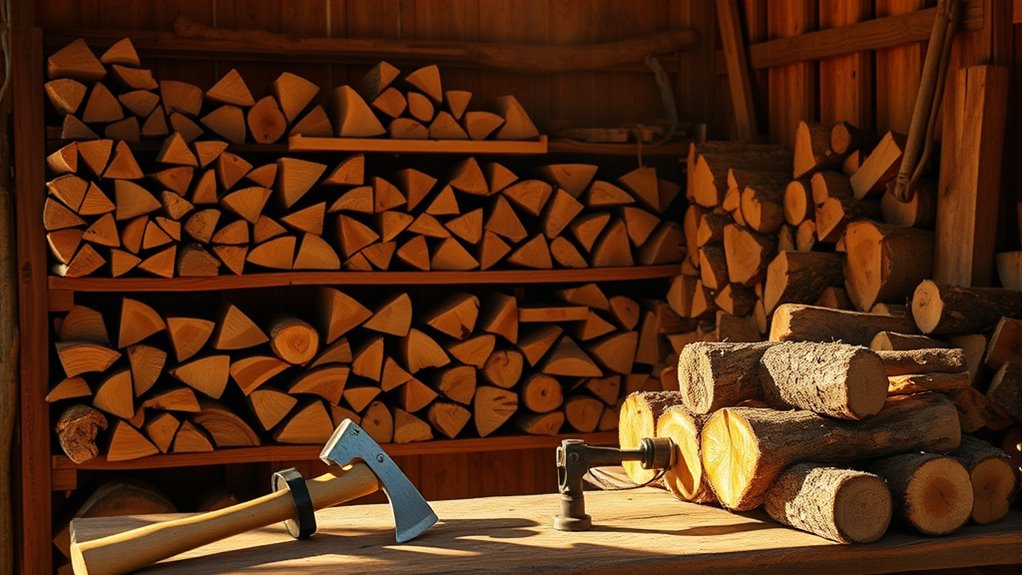
Properly preparing and storing your firewood is essential to guarantee it burns efficiently and produces maximum heat. The key is managing firewood moisture; wet or green wood ignites poorly and produces less heat. To ensure dryness, store your wood in well-ventilated storage containers or stacks off the ground, allowing air to circulate freely. Cover the top to protect it from rain and snow, but leave sides open for airflow. Proper storage prevents moisture buildup, reducing the chances of mold and decay. When firewood is adequately seasoned and stored correctly, it ignites faster, burns cleaner, and produces more heat. Additionally, understanding the artistic significance of well-preserved firewood can enhance your appreciation for traditional methods of wood preparation. Using a moisture meter can help you determine the moisture content of your firewood, ensuring it is properly seasoned before use. Maintaining proper firewood storage practices not only improves combustion efficiency but also prolongs the lifespan of your firewood supply. Incorporating sustainable forestry principles when sourcing your wood can further support eco-friendly living. Taking these steps ensures your small wood stove operates at peak efficiency, maximizing heat output while minimizing fuel waste.
Use Dry, Seasoned Wood for Better Combustion

Using dry, seasoned wood guarantees cleaner, more efficient burns in your stove. Proper storage methods help keep your firewood dry and ready to use, so you get the most heat. Recognizing dry wood is simple: it sounds hollow when tapped and has cracks in the bark. Additionally, selecting best anime movies can be a great way to relax after a cozy fire. To ensure optimal combustion, it’s important to consider the water content of your firewood, as high moisture levels reduce heat output and increase smoke. Monitoring air quality around your stove can also help you maintain safe and efficient operation. Regularly inspecting your stove’s gaskets and seals ensures safe and efficient operation, preventing heat loss and leaks. Paying attention to cooking techniques related to firewood can further improve your stove’s performance and safety.
Proper Storage Methods
To guarantee your wood stove burns efficiently, it’s essential to store your firewood properly. Using the right wood storage methods helps with moisture control, resulting in better combustion and more heat. Store your wood in a dry, well-ventilated area off the ground. Cover the top to protect from rain, but leave sides open for airflow. Season your wood for at least 6-12 months before burning. Proper storage prevents moisture buildup, reducing smoke and creosote. Incorporate home organization strategies like stacking wood neatly and keeping the storage area clutter-free to maintain optimal conditions. Selecting keto-friendly ingredients for your storage area, such as avoiding treated or contaminated wood, can further enhance safety and efficiency. Additionally, ensuring proper ventilation in your storage area helps maintain the ideal moisture level for seasoned wood.
Recognize Dry Wood
Since wet or green wood contains high moisture content, it burns inefficiently and produces more smoke and creosote. To maximize heat output, always choose properly seasoned wood. Proper wood seasoning reduces moisture content, making it easier to ignite and sustain a hotter, cleaner burn. You can recognize dry wood by its weight—seasoned wood feels lighter—and by its appearance: it should have cracks in the ends and a dull, matte surface. Avoid buying or stacking green or unseasoned wood; instead, store your wood in a dry, ventilated area for at least 6 to 12 months. Using dry, seasoned wood ensures better combustion, less creosote buildup, and more heat from each load. Properly seasoned wood is your best tool for efficient, effective heating.
Optimize Airflow for Efficient Burning

Proper airflow is essential for maximizing heat output from your small wood stove. Good airflow control ensures your fire burns efficiently, producing consistent heat. Managing draft properly helps regulate oxygen supply, preventing smoldering or over-firing. To optimize airflow:
Ensuring proper airflow maximizes heat and efficiency in your small wood stove.
- Adjust the air intake vents to match your burn stage
- Keep the damper partially open for steady draft management
- Avoid overloading the stove, which can restrict airflow
- Use kindling to promote a strong, clean burn
- Regularly clean your stove and chimney to maintain optimal airflow, reducing creosote buildup that can impede draft effectiveness. Proper maintenance also supports remote work productivity by ensuring your space remains safe and efficient. Additionally, understanding combustion efficiency helps you fine-tune your stove for better heat output and lower emissions. Monitoring draft control can further optimize your burn process and heat performance.
Maintain and Clean Your Stove Regularly

You should clean your stove regularly to keep it running efficiently. Remove ashes promptly to prevent blockages, and check gaskets for wear to guarantee a proper seal. Regular inspections help maintain peak heat output and extend your stove’s lifespan. Additionally, considering performance upgrades can further increase heat efficiency. Incorporating proper exfoliation techniques in your maintenance routine can help remove stubborn residue and improve overall stove performance. Employing automation’s role in business intelligence principles by utilizing automated cleaning tools can also streamline maintenance and ensure consistent stove operation. Regularly inspecting hoses and seals for wear aligns with recommended maintenance and troubleshooting practices to prevent issues and prolong your stove’s service life. Recognizing the importance of heartfelt appreciation for your stove’s reliability can motivate consistent upkeep and care.
Regular Ash Removal
Regular ash removal is essential for keeping your small wood stove operating efficiently. Ash accumulation can block airflow, reducing heat output and increasing fuel consumption. To maintain ideal performance, regularly clear out the ash from the firebox. Proper ash disposal prevents buildup that hampers combustion and ensures better heat transfer.
Here’s what to do:
- Remove excess ash before it reaches the top of the ash pan
- Use a metal container for safe ash disposal
- Check for hidden ash pockets that can restrict airflow
- Clean out ash regularly to prevent clogging and maintain consistent burning
Inspect and Replace Gaskets
Since gaskets form the seal between your stove’s door and firebox, inspecting them regularly helps prevent drafts and heat loss. Check the gasket material for signs of wear, cracks, or gaps that could compromise the seal. Gasket material varies, so ensure yours remains flexible and intact. If you notice deterioration, replace the gasket promptly to maintain top-notch sealing techniques. Proper sealing techniques involve fitting the new gasket snugly around the door frame and securing it with the appropriate fasteners. A well-maintained gasket ensures maximum heat retention, improves stove efficiency, and reduces fuel consumption. Regular inspections and timely replacements keep your stove operating at peak performance, helping you get the most heat output from your small wood stove. Additionally, understanding relationship dynamics and maintaining good communication can also enhance your overall experience with the stove and your living space.
Maximize Heat Distribution in Your Space
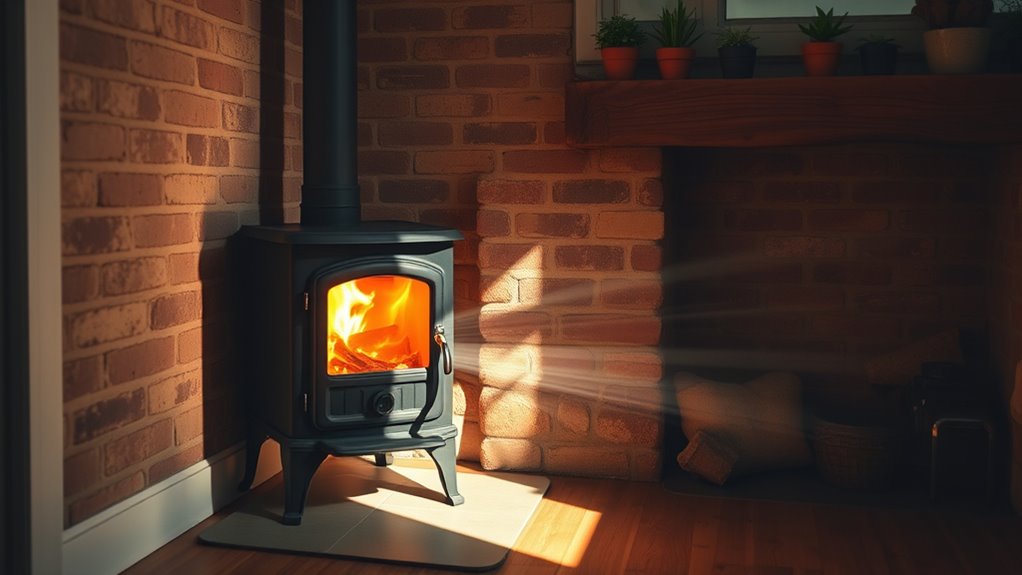
To effectively distribute heat from your small wood stove, it’s essential to optimize airflow and placement within the room. Proper airflow adjustment ensures warm air circulates evenly, preventing cold spots. You can achieve better heat circulation by positioning the stove centrally and using fans to direct warm air outward. Additionally, consider these tips:
Optimizing airflow and central placement maximizes heat circulation from your small wood stove.
- Use a ceiling fan to enhance heat distribution
- Keep furniture and drapes away from the stove’s airflow path
- Install heat reflectors behind the stove to bounce warmth into the room
- Open interior doors to allow warm air to circulate between spaces
These adjustments help maximize heat output, making your space warmer and more comfortable. Focus on improving airflow and circulation to get the most from your small wood stove effectively.
Use Supplemental Heat Strategies Wisely
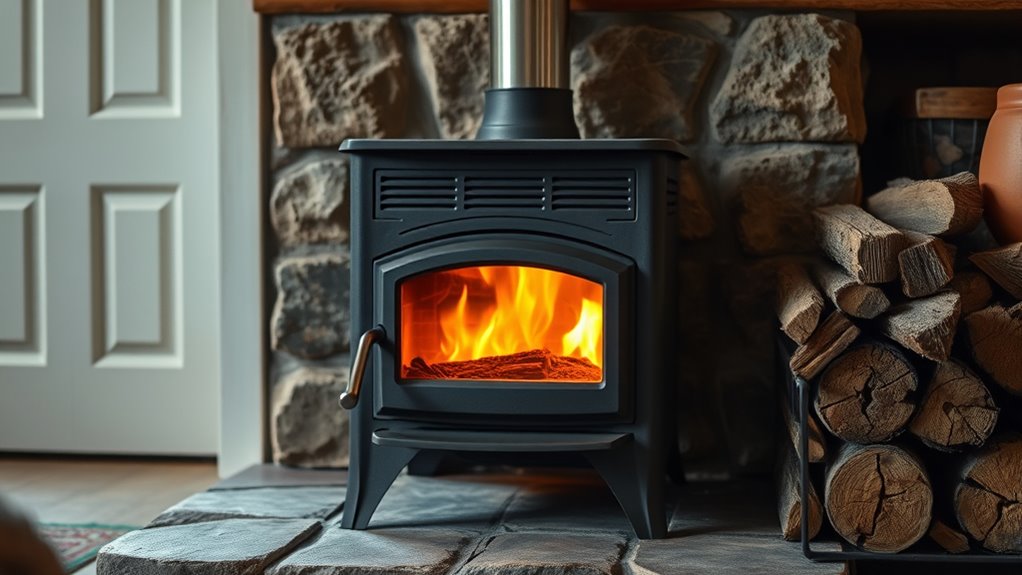
Using supplemental heat sources can boost your home’s warmth, especially during cold snaps or when the wood stove alone isn’t enough. To maximize efficiency, combine your stove with strategic options like electric heaters or space heaters, but use them wisely. Focus on weatherproofing tips and insulation techniques to retain heat and reduce energy waste. Properly sealing windows and doors, adding insulation to walls and attics, and using draft stoppers can make a big difference. Be mindful of your energy budget and avoid over-reliance on supplemental heat, which can increase costs. Here’s a quick overview of effective strategies:
| Strategy | Benefit | Implementation Tip |
|---|---|---|
| Weatherproofing Tips | Keeps cold out, warmth in | Seal gaps around windows |
| Insulation Techniques | Improves heat retention | Add attic insulation |
| Supplemental Heating | Boosts warmth during cold | Use portable heaters |
| Proper Ventilation | Prevents moisture buildup | Keep vents clear |
Frequently Asked Questions
How Can I Prevent Creosote Buildup in My Small Stove?
To prevent creosote buildup in your small stove, you should regularly schedule chimney cleaning to remove soot and tar deposits. Use properly seasoned firewood and store fuel in a dry, well-ventilated area to guarantee efficient burning. Avoid overloading the stove and maintain good airflow during fires. These steps help reduce creosote formation, keep your stove burning safely, and improve overall efficiency.
What Safety Precautions Should I Follow During Stove Operation?
Think of your stove as a trusted guard in your home, requiring clear communication channels. You should prioritize ventilation safety by ensuring proper airflow and keeping the area clear of combustibles. Always use a stove thermometer to prevent overheating and never leave fires unattended to avoid fire prevention issues. Regularly inspect the chimney for creosote buildup and keep a fire extinguisher nearby, so you’re prepared if safety concerns arise.
How Do I Identify Signs of a Faulty Stove Vent?
To spot signs of a faulty stove vent, you should watch for ventilation issues like sluggish smoke clearance or strong odors. If your stove produces excessive smoke or you notice soot buildup, these are red flags. Regular chimney inspection helps catch problems early, such as blockages or leaks. Addressing these issues promptly ensures safe operation and peak heat output, preventing dangerous smoke backup or fire hazards.
Can Different Wood Species Affect Heat Output Efficiency?
Think of your wood stove like a symphony, where each wood species plays a different tune. Different woods, with their varying wood density and combustion temperature, influence heat output efficiency. Hardwoods like oak burn longer and hotter, providing more consistent warmth, while softer woods burn faster but produce less heat. Choosing the right wood guarantees your stove performs at its best, turning small sparks into a roaring fire of warmth.
What Are Eco-Friendly Options for Reducing Emissions?
To cut emissions eco-friendly, you can explore solar heating options, which use renewable energy and produce no emissions. Biomass alternatives like pellet stoves burn compressed wood or other organic materials cleaner than traditional firewood. Combining these methods reduces your carbon footprint, helps the environment, and keeps your home warm efficiently. Consider integrating solar heating with biomass options for a sustainable, low-emission heating solution.
Conclusion
By following these tips, you can get the most heat out of your small wood stove and keep your space cozy all season long. Have you considered how small adjustments—like proper wood prep or airflow tweaks—can make a big difference? Don’t settle for inefficient burning; maximize every log and keep your home warm and inviting. After all, isn’t a warmer home worth the effort?

